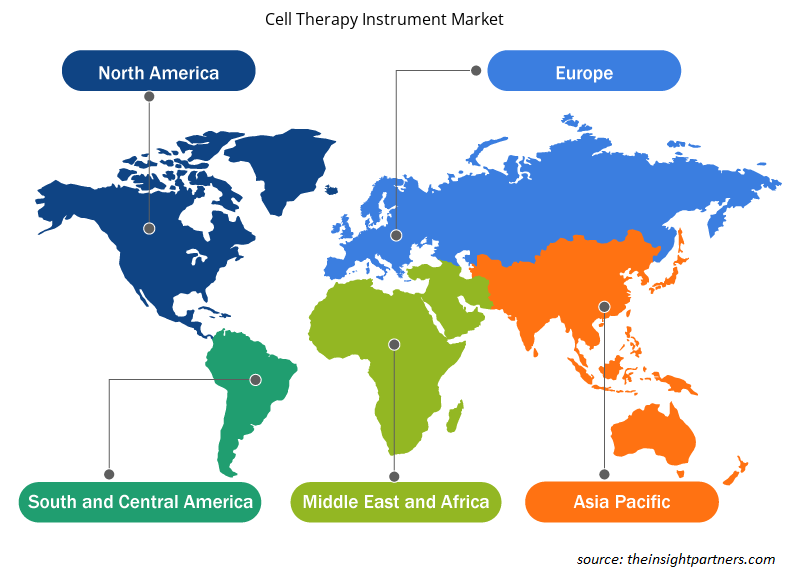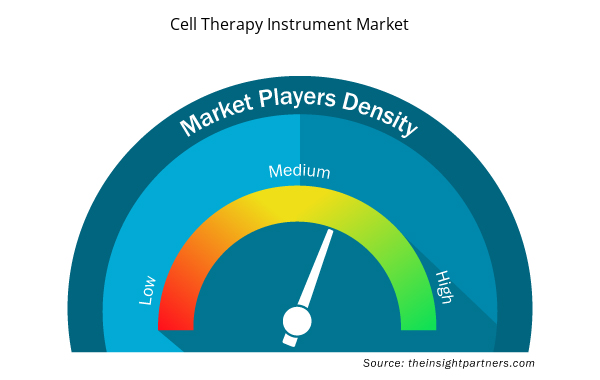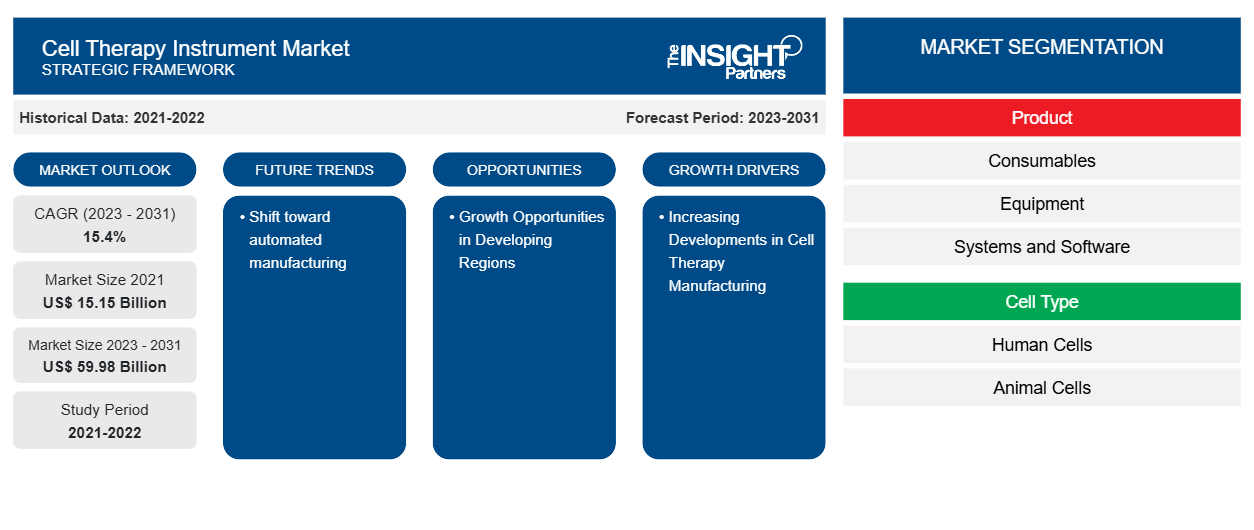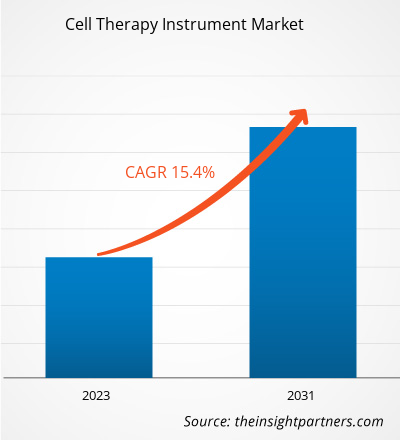細胞治療機器市場は2021年に151億5,000万米ドルと評価され、2031年までに599億8,000万米ドルに達すると予想されています。市場は2023年から2031年にかけて15.4%のCAGRを記録すると予想されています。自動化製造への移行は、細胞治療機器市場の主要なトレンドであり続けると思われます。
細胞治療機器市場分析
細胞療法とは、生きた無傷の細胞を患者の体に注入、移植、または移植することです。たとえば、がん患者は免疫療法の過程で T 細胞を注入されます。細胞療法器具の投与は、注射から特殊な装置を使用した外科的移植まで多岐にわたります。細胞療法は、多数の疾患に応用されています。神経系の最も重要な疾患はがんであり、その他の用途には、心臓疾患 (心筋梗塞および心不全)、糖尿病、骨および関節、遺伝性疾患、皮膚および軟部組織の創傷などがあります。
細胞治療機器市場の概要
がん治療の最も有望な方法の一つはキメラ抗原受容体(CAR)T細胞療法であり、毎年、その適用を拡大するために膨大な数の前臨床および臨床試験が実施されています。数十年にわたる研究の後、CAR-T細胞療法は必然的に拡大するでしょう。自己および同種製品に加えて、新しい生体内CAR-T細胞遺伝子療法や、血液悪性腫瘍以外の適応症での有効性も、細胞療法の将来において研究されるでしょう。
要件に合わせてレポートをカスタマイズする
このレポートの一部、国レベルの分析、Excelデータパックなど、あらゆるレポートを無料でカスタマイズできます。また、スタートアップや大学向けのお得なオファーや割引もご利用いただけます。
- このレポートの主要な市場動向を入手してください。この無料サンプルには、市場動向から見積もりや予測に至るまでのデータ分析が含まれます。
細胞治療機器市場の推進要因と機会
細胞治療製造における開発の増加
細胞療法の研究活動の増加により、遺伝性疾患を治療し、免疫システムを効率的に改善するための細胞療法機器の驚くべき治療開発が進んでいます。さまざまな市場プレーヤーが試薬キットや酵素などの消耗品を提供しており、多くの企業が幅広い細胞療法プロセスを実施するための機器、装置、ソフトウェアを提供しています。
T 細胞、HSC、MSC、PSC、NSC などの細胞療法の製造には、機器の使用が重要です。これらの細胞療法製品は、ヒトまたは動物の細胞から得られるため、汚染のない安全な条件が必要です。したがって、細胞療法に使用される機器は、汚染を防ぎ、生産のスケールアップを可能にします。たとえば、Corning Incorporated、Hitachi Chemical Advanced Therapeutics Solutions、LLC、Cytiva (General Electric Company)、Thermo Fisher Scientific Inc.、Invetech、Miltenyi Biotec などの企業は、細胞療法用のさまざまな機器と消耗品を導入しています。HSC, MSC, PSC, and NSC. These cell therapy products are derived from human or animal cells and thus require safe conditions from contamination. Thus, the instruments used for LLC, Cytiva (General Electric Company), Thermo Fisher Scientific Inc., Invetech, and Miltenyi Biotec have introduced various instruments and consumables for cell therapy.
発展途上地域における成長機会 - 細胞治療機器市場における機会
アジア太平洋および中東のバイオテクノロジー分野は、北米およびヨーロッパ地域の国々との民間および公的機関による多額の投資と戦略的開発のサポートを受けて急速に成長しています。たとえば、2019年12月、アステラス製薬株式会社(日本)は、遺伝子治療会社であるAudentes Therapeutics Inc.を30億米ドルで買収する契約を締結しました。同様に、2019年11月、富士フイルムは、組織の契約開発および製造セグメントの一環として、遺伝子治療に約1億2千万米ドル(130億円)を投資する計画を立てました。また、日本の医薬品医療機器総合機構(PMDA)は、2つの遺伝子治療製品を承認しました。これらの製品は、FDAの画期的治療指定およびEMAの優先医薬品(PRIME)指定に相当し、少なくとも年間1つの治療法が承認されると見込まれる先駆け審査指定の下で同時に承認されました。アジア諸国の国内プレーヤーによる細胞治療分野におけるこのような戦略的開発は、今後、細胞治療機器の需要を増加させる可能性があります。
細胞治療機器市場レポートのセグメンテーション分析
細胞治療機器市場分析の導出に貢献した主要セグメントは、疾患およびサービスプロバイダーです。
- 製品に基づいて、細胞治療機器市場は消耗品、機器、システム、ソフトウェアに分類されます。消耗品セグメントは2023年に大きな市場シェアを占めました。
- 細胞の種類別に見ると、細胞治療機器市場はヒト細胞、動物細胞に分類されます。熱可塑性プラスチックセグメントは、2023年に市場で最大のシェアを占めました。
- プロセス別に見ると、細胞治療機器市場は、細胞処理、プロセス監視と品質管理、細胞保存、配布、取り扱いに分類されます。細胞処理セグメントは、2023年に市場で最大のシェアを占めました。
- エンドユーザー別に見ると、細胞治療機器市場は研究機関、ライフサイエンス研究会社、その他のエンドユーザーに分かれています。ライフサイエンス研究会社セグメントは2023年に最大の市場シェアを占めました。
細胞治療機器の地域別市場シェア分析
細胞治療機器市場レポートの地理的範囲は、主に北米、アジア太平洋、ヨーロッパ、中東およびアフリカ、南米/中南米の 5 つの地域に分かれています。
米国は、細胞治療機器の最大かつ最も急速に成長している市場です。市場の成長は、研究開発の増加と、遺伝子、幹細胞、免疫療法などの細胞治療の採用の増加に起因しています。さらに、政府からの支援の増加が細胞治療の成長を促進し、市場の成長に影響を与えています。たとえば、公的機関である米国遺伝子細胞治療学会 (ASGCT) は、遺伝子および細胞治療に携わる科学者、医師、専門家、および患者擁護者に会員資格を提供しています。ASGCT は、細胞および遺伝子治療の臨床応用に関する知識、教育、および認識を高めることを目指しています。
細胞治療機器市場の地域別洞察
予測期間を通じて細胞治療機器市場に影響を与える地域的な傾向と要因は、Insight Partners のアナリストによって徹底的に説明されています。このセクションでは、北米、ヨーロッパ、アジア太平洋、中東、アフリカ、南米、中米にわたる細胞治療機器市場のセグメントと地理についても説明します。

- 細胞治療機器市場の地域別データを入手
細胞治療機器市場レポートの範囲
| レポート属性 | 詳細 |
|---|---|
| 2021年の市場規模 | 151.5億米ドル |
| 2031年までの市場規模 | 599.8億米ドル |
| 世界のCAGR(2023年~2031年) | 15.4% |
| 履歴データ | 2021-2022 |
| 予測期間 | 2023-2031 |
| 対象セグメント | 製品別
|
| 対象地域と国 | 北米
|
| 市場リーダーと主要企業プロフィール |
|
細胞治療機器市場のプレーヤー密度:ビジネスダイナミクスへの影響を理解する
細胞治療機器市場は、消費者の嗜好の変化、技術の進歩、製品の利点に対する認識の高まりなどの要因により、エンドユーザーの需要が高まり、急速に成長しています。需要が高まるにつれて、企業は提供を拡大し、消費者のニーズを満たすために革新し、新たなトレンドを活用し、市場の成長をさらに促進しています。
市場プレーヤー密度とは、特定の市場または業界内で活動している企業または会社の分布を指します。これは、特定の市場スペースに、その市場規模または総市場価値に対してどれだけの競合相手 (市場プレーヤー) が存在するかを示します。
細胞治療機器市場で事業を展開している主要企業は次のとおりです。
- サーモフィッシャーサイエンティフィック株式会社
- メルク
- ロンザ
- Cytiva(GEヘルスケアライフサイエンス)
- テルモ株式会社
- BD
免責事項:上記の企業は、特定の順序でランク付けされていません。

- 細胞治療機器市場のトップキープレーヤーの概要を入手
細胞治療機器市場のニュースと最近の動向
細胞治療機器市場は、主要な企業出版物、協会データ、データベースを含む一次調査および二次調査後の定性的および定量的データを収集することによって評価されます。以下は、足矯正インソールの市場における動向の一覧です。
- サーモフィッシャーサイエンティフィックとロボット工学の専門企業である Multiply Labs は、細胞治療の製造を自動化するための協力関係をさらに強化する契約を締結しました。(出典: サーモフィッシャーサイエンティフィック、2024 年)
- MaxCyte は、コンセプトから商品化まで次世代細胞療法のための統合技術プラットフォームを提供するために、ExPERT 機器ファミリーを発売しました。(出典: MaxCyte、プレスリリース、2019 年)。
細胞治療機器市場レポートの対象範囲と成果物
「細胞治療機器市場規模と予測(2021〜2031年)」レポートでは、以下の分野をカバーする市場の詳細な分析を提供しています。
- 対象範囲に含まれるすべての主要市場セグメントの世界、地域、国レベルでの市場規模と予測
- 市場の動向(推進要因、制約、主要な機会など)
- 今後の主な動向
- 詳細なPEST/ポーターの5つの力とSWOT分析
- 主要な市場動向、主要プレーヤー、規制、最近の市場動向を網羅した世界および地域の市場分析
- 市場集中、ヒートマップ分析、主要プレーヤー、最近の動向を網羅した業界の状況と競争分析
- 詳細な企業プロフィール
- 過去2年間の分析、基準年、CAGRによる予測(7年間)
- PEST分析とSWOT分析
- 市場規模価値/数量 - 世界、地域、国
- 業界と競争環境
- Excel データセット



Report Coverage
Revenue forecast, Company Analysis, Industry landscape, Growth factors, and Trends

Segment Covered
This text is related
to segments covered.

Regional Scope
North America, Europe, Asia Pacific, Middle East & Africa, South & Central America

Country Scope
This text is related
to country scope.
Trends and growth analysis reports related to Life Sciences : READ MORE..
The Insight Partners performs research in 4 major stages: Data Collection & Secondary Research, Primary Research, Data Analysis and Data Triangulation & Final Review.
- Data Collection and Secondary Research:
As a market research and consulting firm operating from a decade, we have published and advised several client across the globe. First step for any study will start with an assessment of currently available data and insights from existing reports. Further, historical and current market information is collected from Investor Presentations, Annual Reports, SEC Filings, etc., and other information related to company’s performance and market positioning are gathered from Paid Databases (Factiva, Hoovers, and Reuters) and various other publications available in public domain.
Several associations trade associates, technical forums, institutes, societies and organization are accessed to gain technical as well as market related insights through their publications such as research papers, blogs and press releases related to the studies are referred to get cues about the market. Further, white papers, journals, magazines, and other news articles published in last 3 years are scrutinized and analyzed to understand the current market trends.
- Primary Research:
The primarily interview analysis comprise of data obtained from industry participants interview and answers to survey questions gathered by in-house primary team.
For primary research, interviews are conducted with industry experts/CEOs/Marketing Managers/VPs/Subject Matter Experts from both demand and supply side to get a 360-degree view of the market. The primary team conducts several interviews based on the complexity of the markets to understand the various market trends and dynamics which makes research more credible and precise.
A typical research interview fulfils the following functions:
- Provides first-hand information on the market size, market trends, growth trends, competitive landscape, and outlook
- Validates and strengthens in-house secondary research findings
- Develops the analysis team’s expertise and market understanding
Primary research involves email interactions and telephone interviews for each market, category, segment, and sub-segment across geographies. The participants who typically take part in such a process include, but are not limited to:
- Industry participants: VPs, business development managers, market intelligence managers and national sales managers
- Outside experts: Valuation experts, research analysts and key opinion leaders specializing in the electronics and semiconductor industry.
Below is the breakup of our primary respondents by company, designation, and region:

Once we receive the confirmation from primary research sources or primary respondents, we finalize the base year market estimation and forecast the data as per the macroeconomic and microeconomic factors assessed during data collection.
- Data Analysis:
Once data is validated through both secondary as well as primary respondents, we finalize the market estimations by hypothesis formulation and factor analysis at regional and country level.
- Macro-Economic Factor Analysis:
We analyse macroeconomic indicators such the gross domestic product (GDP), increase in the demand for goods and services across industries, technological advancement, regional economic growth, governmental policies, the influence of COVID-19, PEST analysis, and other aspects. This analysis aids in setting benchmarks for various nations/regions and approximating market splits. Additionally, the general trend of the aforementioned components aid in determining the market's development possibilities.
- Country Level Data:
Various factors that are especially aligned to the country are taken into account to determine the market size for a certain area and country, including the presence of vendors, such as headquarters and offices, the country's GDP, demand patterns, and industry growth. To comprehend the market dynamics for the nation, a number of growth variables, inhibitors, application areas, and current market trends are researched. The aforementioned elements aid in determining the country's overall market's growth potential.
- Company Profile:
The “Table of Contents” is formulated by listing and analyzing more than 25 - 30 companies operating in the market ecosystem across geographies. However, we profile only 10 companies as a standard practice in our syndicate reports. These 10 companies comprise leading, emerging, and regional players. Nonetheless, our analysis is not restricted to the 10 listed companies, we also analyze other companies present in the market to develop a holistic view and understand the prevailing trends. The “Company Profiles” section in the report covers key facts, business description, products & services, financial information, SWOT analysis, and key developments. The financial information presented is extracted from the annual reports and official documents of the publicly listed companies. Upon collecting the information for the sections of respective companies, we verify them via various primary sources and then compile the data in respective company profiles. The company level information helps us in deriving the base number as well as in forecasting the market size.
- Developing Base Number:
Aggregation of sales statistics (2020-2022) and macro-economic factor, and other secondary and primary research insights are utilized to arrive at base number and related market shares for 2022. The data gaps are identified in this step and relevant market data is analyzed, collected from paid primary interviews or databases. On finalizing the base year market size, forecasts are developed on the basis of macro-economic, industry and market growth factors and company level analysis.
- Data Triangulation and Final Review:
The market findings and base year market size calculations are validated from supply as well as demand side. Demand side validations are based on macro-economic factor analysis and benchmarks for respective regions and countries. In case of supply side validations, revenues of major companies are estimated (in case not available) based on industry benchmark, approximate number of employees, product portfolio, and primary interviews revenues are gathered. Further revenue from target product/service segment is assessed to avoid overshooting of market statistics. In case of heavy deviations between supply and demand side values, all thes steps are repeated to achieve synchronization.
We follow an iterative model, wherein we share our research findings with Subject Matter Experts (SME’s) and Key Opinion Leaders (KOLs) until consensus view of the market is not formulated – this model negates any drastic deviation in the opinions of experts. Only validated and universally acceptable research findings are quoted in our reports.
We have important check points that we use to validate our research findings – which we call – data triangulation, where we validate the information, we generate from secondary sources with primary interviews and then we re-validate with our internal data bases and Subject matter experts. This comprehensive model enables us to deliver high quality, reliable data in shortest possible time.


 このレポートの無料サンプルを入手する
このレポートの無料サンプルを入手する